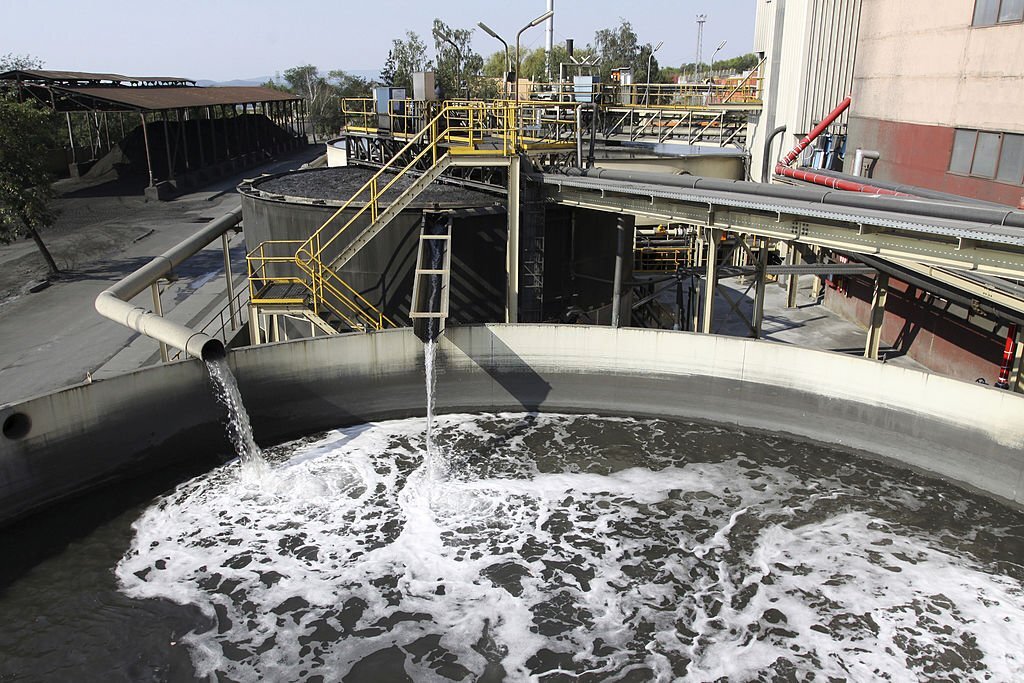As the population continues to grow and urbanisation expands, the need for effective wastewater management becomes increasingly critical. Sewage treatment plants play a pivotal role in safeguarding the environment and public health by treating and purifying wastewater before it is discharged into natural water bodies.
One of the most widely used and successful methods in wastewater treatment is the activated sludge process. This article delves into the essential components and operational aspects of an activated sludge plant.

What is Activated Sludge?
Activated sludge is a biological wastewater treatment process that utilises microorganisms to break down organic matter and pollutants in the water. The process involves introducing a mixture of wastewater and microorganisms into aeration tanks, where the microorganisms consume and metabolise the organic materials in the wastewater. These microorganisms form flocs, which are later separated from the treated water in a settling tank. The treated water is then either discharged or subjected to further treatment to meet specific regulatory standards.
Activated Sludge Plant Components
Aeration Tanks
The aeration tanks are the heart of the activated sludge process. These tanks facilitate the growth and sustenance of microorganisms by providing the necessary oxygen through diffusers or mechanical aerators. The efficient transfer of oxygen is crucial for fostering microbial activity, as it directly influences the treatment efficiency of the sewage treatment plant.
Settling Tanks (Clarifiers)
After the aeration stage, the wastewater-microorganism mixture flows into settling tanks, where the activated sludge particles settle at the bottom, resulting in clarified water at the top.
Return Sludge Pump
The return sludge pump is responsible for recycling a portion of the settled sludge (activated sludge) back into the aeration tank. This process, known as Return Activated Sludge (RAS), helps maintain an optimum population of microorganisms for efficient and stable treatment.
Sludge Treatment and Disposal System
The excess sludge, also known as surplus-activated sludge (Waste Activated Sludge – WAS), is removed from the system and treated before proper disposal. The treatment of surplus-activated sludge is crucial to minimise the environmental impact and ensure the sustainability of the plant.
Steps Involved in the Activated Sludge Plant Process
The activated sludge process is highly effective in removing organic matter, suspended solids, and nutrients from wastewater. It involves several key stages:
Aeration
In the aeration tank, microorganisms are mixed with the incoming wastewater and provided with oxygen through diffused aeration or mechanical agitation. This promotes microbial growth and enhances the breakdown of pollutants. The efficiency of the aeration process is influenced by factors such as the design of aeration systems, dissolved oxygen levels, and the retention time of the microorganisms in the tank.
Settling
After the aeration stage, the mixture enters the settling tank, where the activated sludge particles settle at the bottom, forming a sludge blanket. The clarified water rises to the top and is collected for further treatment. The efficiency of the settling process is affected by factors like the settling tank design, hydraulic flow, and the characteristics of the sludge. This process plays a vital role in separating the treated water from the activated sludge, making it ready for the next treatment stage.
Sludge Return
A portion of the settled sludge is recycled back into the aeration tank through the return sludge pump. This ensures a continuous supply of active microorganisms for efficient treatment and helps stabilise the biological process against variations in influent characteristics.
Return Activated Sludge (RAS)
Return Activated Sludge (RAS) is the portion of settled sludge that is returned from the clarifier to the aeration tank. Proper control and adjustment of RAS play a crucial role in maintaining the stability and performance of the activated sludge process. The RAS rate must be optimised to strike a balance between ensuring sufficient biomass for efficient treatment and preventing unnecessary sludge wastage.
Surplus Activated Sludge (Waste Activated Sludge – WAS)
Surplus-activated sludge, also known as Waste Activated Sludge (WAS), refers to the excess sludge that is not recycled back to the aeration tank. This excess sludge is processed further to reduce its volume and stabilise its organic content before disposal. Proper sludge management is essential to ensure compliance with environmental regulations and to minimise the impact on landfills or other disposal methods.
Types of Activated Sludge
Tapered Aeration
The tapered aeration method involves reducing the oxygen supply in the aeration tank from the inlet to the outlet. By gradually decreasing the oxygen concentration, the microorganisms experience different environmental conditions, leading to improved treatment efficiency and energy savings.
Step Aeration
Step aeration divides the aeration tank into several zones with varying oxygen levels. This approach allows different stages of microbial growth and pollutant removal to occur in each zone, leading to enhanced treatment effectiveness and nutrient removal.
High-Rate Treatment or Modified Aeration
This method operates at higher mixed liquor suspended solids (MLSS) concentrations compared to conventional systems. This higher concentration promotes higher biomass activity and a more compact wastewater treatment plant, making it suitable for areas with limited available land.
Two-Stage Aeration
In this process, two separate aeration tanks are used. Each tank is designed to perform specific treatment functions, allowing aeration and settling to occur simultaneously in each tank. This leads to improved treatment efficiency and a smaller plant footprint.
Activated Aeration
This method involves the use of pure oxygen instead of air for the aeration process. This approach significantly enhances microbial activity and promotes faster pollutant degradation, making it suitable for wastewater with high organic loads or specific industrial effluents.
Reaeration
This is the process of adding fresh oxygen to the effluent before its discharge. This step is essential in ensuring that the treated water meets the required dissolved oxygen levels to support aquatic life and maintain the ecological balance in receiving water bodies.
Contact Stabilization
Here, wastewater is first mixed with recycled activated sludge in a contact tank, where organic matter is partially stabilised. The mixture is then transferred to aeration tanks for further treatment. This process is known for its ability to handle shock loads and improve the overall stability of the biological treatment process.
Complete Mix
The complete mix-activated sludge system ensures uniform mixing of wastewater and microorganisms throughout the aeration tank. This ensures that all influent particles come into contact with microorganisms, leading to consistent treatment and effluent quality.
Extended Aeration Method
This method involves prolonged aeration and retention time in the aeration tank. This extended treatment allows for more comprehensive organic matter breakdown and nutrient removal, often making it suitable for small to medium-sized wastewater treatment plants.
Factors that Affect the Cost of Sewage Treatment Plant
Plant Capacity
The size and capacity of a sewage treatment plant significantly impact the overall cost. Larger plants with higher treatment capacities generally involve more significant investments in terms of infrastructure, equipment, and operational expenses.
Technology and Equipment
The choice of technology and equipment used in the treatment process influences the cost. Advanced and innovative technologies may require higher initial investments but can lead to long-term cost savings through improved treatment efficiency and reduced operational costs.
Land and Location
The cost of land acquisition and site preparation varies depending on the location of the plant. Sites with challenging terrain, environmental restrictions, or higher land prices might entail additional expenses.
Regulatory Compliance
The need to meet stringent regulatory standards can result in additional costs for incorporating specialised treatment processes or advanced tertiary treatment. Compliance with environmental regulations is essential to avoid penalties and ensure the sewage treatment plant’s sustainability.
Operations and Maintenance
Ongoing operational and maintenance costs must be considered during the planning phase. Efficient design, automated control systems, and proper maintenance protocols can help optimise these expenses over the plant’s operational life.
Sludge Management
Proper disposal or treatment of surplus-activated sludge adds to the overall cost. Sludge management includes sludge thickening, dewatering, and proper disposal methods such as incineration, land application, or composting.
Energy Consumption
The energy consumption of the sewage treatment plant, especially for aeration and other energy-intensive processes, contributes to operating costs. Energy-efficient equipment and renewable energy integration can help mitigate these expenses.
Skilled Labor
The availability of skilled labour and their remuneration affect the overall cost, especially during the construction and commissioning phase. Well-trained operators and technicians are essential for maintaining the plant’s efficient operation and ensuring effective troubleshooting.
Contingency and Financing
Setting aside funds for contingencies and selecting an appropriate financing option also impact the total project cost. Adequate contingency planning helps address unexpected challenges, while the choice of financing affects the debt service and interest payments over time.
Get the Best Wastewater Treatment Plant
Discover a world of comprehensive wastewater treatment solutions at Cleantech Water! Our MBR-based sewage treatment plant, an ingenious fusion of activated sludge processes and membrane filtration, ensures top-notch water purification. But that’s not all. We go beyond our range of advanced sewage treatment systems, including SBR and MBBR plants.
At Cleantech Water, we understand the diverse needs of our clients, which is why we offer a wide array of cutting-edge technologies to cater to residential, commercial, and industrial sectors. With our SBR and MBBR sewage treatment plants, you get the same level of excellence, efficiency, and environmental consciousness that our MBR systems are renowned for.
Take the first step towards sustainable wastewater management today. Embrace the future with Cleantech Water’s innovative wastewater treatment plant solutions. Contact us at +91-9558996411 or email your queries at info@cleantechwater.co.in and let our experts tailor a solution that perfectly fits your requirements while contributing to a greener and cleaner tomorrow.

